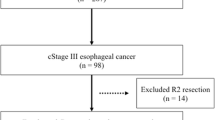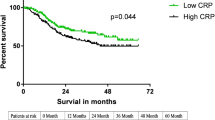Abstract
Background
Elevated preoperative serum C-reactive protein (CRP) levels are reportedly associated with a poor prognosis for patients with various types of malignant tumors. However, the impact of postoperative CRP levels on the prognosis of patients with esophageal cancer remains unknown. The present study aims to clarify the prognostic significance of postoperative CRP levels on the survival of patients with esophageal cancer.
Methods
We reviewed the records of consecutive 202 patients with thoracic esophageal squamous cell carcinoma who underwent transthoracic esophagectomy. We measured serum CRP levels on postoperative days (PODs) 1, 2, 3, 5 and 7 and evaluated the relationships between postoperative CRP levels and survival.
Results
The findings of Cox regression analyses suggested that elevated CRP levels on POD 3, 5 and 7 were associated with poor recurrence-free survival (RFS). We divided CRP levels on POD 7 into three tertiles and found that RFS could be clearly stratified, being the poorest (p < 0.001) in the highest tertile (high CRP). The trend was similar even in patients with or without infectious complications and with or without advanced pathological stage. Multivariate analysis showed that pathologically advanced stage (Hazard ratio [HR], 5.14; 95% confidence interval [CI] 2.67–9.87; p < 0.001) and high CRP (HR, 2.27; 95% CI 1.3–3.96; p = 0.004) were independent predictors of RFS.
Conclusion
Postoperative CRP levels could predict the prognosis of patients with esophageal cancer. We propose that the clinical course of postoperative CRP level should be carefully monitored as a predictor of survival.




Similar content being viewed by others
References
Shimada H, Nabeya Y, Okazumi S et al (2003) Prediction of survival with squamous cell carcinoma antigen in patients with resectable esophageal squamous cell carcinoma. Surgery 133:486–494
Munck-Wikland E, Kuylenstierna R, Wahren B et al (1988) Tumor markers carcinoembryonic antigen, CA 50, and CA 19-9 and squamous cell carcinoma of the esophagus. Pretreatment screening. Cancer 62:2281–2286
Brockmann JG, St Nottberg H, Glodny B et al (2000) CYFRA 21-1 serum analysis in patients with esophageal cancer. Clin Cancer Res 6:4249–4252
Alifano M, Falcoz PE, Seegers V et al (2011) Preresection serum C-reactive protein measurement and survival among patients with resectable non-small cell lung cancer. J Thorac Cardiovasc Surg 142:1161–1167
Baba H, Kuwabara K, Ishiguro T et al (2013) C-reactive protein as a significant prognostic factor for stage IV gastric cancer patients. Anticancer Res 33:5591–5595
Jang JW, Oh BS, Kwon JH et al (2012) Serum interleukin-6 and C-reactive protein as a prognostic indicator in hepatocellular carcinoma. Cytokine 60:686–693
Szkandera J, Stotz M, Absenger G et al (2014) Validation of C-reactive protein levels as a prognostic indicator for survival in a large cohort of pancreatic cancer patients. Br J Cancer 110:183–188
Hu Q, Gou Y, Sun C et al (2014) The prognostic value of C-reactive protein in renal cell carcinoma: a systematic review and meta-analysis. Urol Oncol 32(50):e1–e8
Nozoe T, Saeki H, Sugimachi K (2001) Significance of preoperative elevation of serum C-reactive protein as an indicator of prognosis in esophageal carcinoma. Am J Surg 182:197–201
Ikeda M, Natsugoe S, Ueno S et al (2003) Significant host- and tumor-related factors for predicting prognosis in patients with esophageal carcinoma. Ann Surg 238:197–202
Shimada H, Nabeya Y, Okazumi S et al (2003) Elevation of preoperative serum C-reactive protein level is related to poor prognosis in esophageal squamous cell carcinoma. J Surg Oncol 83:248–252
Gockel I, Dirksen K, Messow CM et al (2006) Significance of preoperative C-reactive protein as a parameter of the perioperative course and long-term prognosis in squamous cell carcinoma and adenocarcinoma of the oesophagus. World J Gastroenterol 12:3746–3750
Wang CY, Hsieh MJ, Chiu YC et al (2009) Higher serum C-reactive protein concentration and hypoalbuminemia are poor prognostic indicators in patients with esophageal cancer undergoing radiotherapy. Radiother Oncol 92:270–275
Guillem P, Triboulet JP (2005) Elevated serum levels of C-reactive protein are indicative of a poor prognosis in patients with esophageal cancer. Dis Esophagus 18:146–150
Zingg U, Forberger J, Rajcic B et al (2010) Association of C-reactive protein levels and long-term survival after neoadjuvant therapy and esophagectomy for esophageal cancer. J Gastrointest Surg 14:462–469
Ben-Baruch A (2006) Inflammation-associated immune suppression in cancer: the roles played by cytokines, chemokines and additional mediators. Semin Cancer Biol 16:38–52
Keibel A, Singh V, Sharma MC (2009) Inflammation, microenvironment, and the immune system in cancer progression. Curr Pharm Des 15:1949–1955
Hirai T, Yoshimoto A, Iwata T et al (1997) Enhancing effect of thoraco-laparotomy on liver metastasis and the role played by active oxygens in its mechanism. Surg Today 27:1040–1045
Sobin LH, Gospodarowicz MK, Wittekind CH (2009) TNM classification of malignant tumours, 7th edn. Wiley, Hoboken
Dindo D, Demartines N, Clavien PA (2004) Classification of surgical complications: a new proposal with evaluation in a cohort of 6336 patients and results of a survey. Ann Surg 240:205–213
Aarden LA, De Groot ER, Schaap OL et al (1987) Production of hybridoma growth factor by human monocytes. Eur J Immunol 17:1411–1416
Sironi M, Breviario F, Proserpio P et al (1989) IL-1 stimulates IL-6 production in endothelial cells. J Immunol 142:549–553
Shiba H, Furukawa K, Fujiwara Y et al (2013) Postoperative peak serum C-reactive protein predicts outcome of hepatic resection for hepatocellular carcinoma. Anticancer Res 33:705–709
Johnson TV, Abbasi A, Owen-Smith A et al (2010) Postoperative better than preoperative C-reactive protein at predicting outcome after potentially curative nephrectomy for renal cell carcinoma. Urology 76(766):e1–e5
Ito K, Yoshii H, Sato A et al (2011) Impact of postoperative C-reactive protein level on recurrence and prognosis in patients with N0M0 clear cell renal cell carcinoma. J Urol 186:430–435
Chen MF, Chen PT, Lu MS et al (2013) IL-6 expression predicts treatment response and outcome in squamous cell carcinoma of the esophagus. Mol Cancer. doi:10.1186/1476-4598-12-26
Nozoe T, Korenaga D, Futatsugi M et al (2003) Immunohistochemical expression of C-reactive protein in squamous cell carcinoma of the esophagus—significance as a tumor marker. Cancer Lett 192:89–95
Nakatsu T, Motoyama S, Maruyama K et al (2012) Tumoral CRP expression in thoracic esophageal squamous cell cancers is associated with poor outcomes. Surg Today 42:652–658
Roth-Isigkeit A, Hasselbach L, Ocklitz E et al (2001) Inter-individual differences in cytokine release in patients undergoing cardiac surgery with cardiopulmonary bypass. Clin Exp Immunol 125:80–88
Misoph M, Babin-Ebell J (1997) Interindividual variations in cytokine levels following cardiopulmonary bypass. Heart Vessels 12:119–127
Lee Y, Park US, Choi I et al (1998) Human interleukin 6 gene is activated by hepatitis B virus-X protein in human hepatoma cells. Clin Cancer Res 4:1711–1717
Lee YH, Nair S, Rousseau E et al (2005) Microarray profiling of isolated abdominal subcutaneous adipocytes from obese vs non-obese Pima Indians: increased expression of inflammation-related genes. Diabetologia 48:1776–1783
Nagasaki T, Hara M, Nakanishi H et al (2014) Interleukin-6 released by colon cancer-associated fibroblasts is critical for tumour angiogenesis: anti-interleukin-6 receptor antibody suppressed angiogenesis and inhibited tumour-stroma interaction. Br J Cancer 110:469–478
Gado K, Domjan G, Hegyesi H et al (2000) Role of interleukin-6 in the pathogenesis of multiple myeloma. Cell Biol Int 24:195–209
Black S, Kushner I, Samols D (2004) C-reactive protein: minireview. J Biol Chem 279:48487–48490
Sato N, Koeda K, Ikeda K et al (2002) Randomized study of the benefits of preoperative corticosteroid administration on the postoperative morbidity and cytokine response in patients undergoing surgery for esophageal cancer. Ann Surg 236:184–190
Kawahara Y, Ninomiya I, Fujimura T et al (2010) Prospective randomized controlled study on the effects of perioperative administration of a neutrophil elastase inhibitor to patients undergoing video-assisted thoracoscopic surgery for thoracic esophageal cancer. Dis Esophagus 23:329–339
Wada Y, Yoshida K, Hihara J et al (2006) Sivelestat, a specific neutrophil elastase inhibitor, suppresses the growth of gastric carcinoma cells by preventing the release of transforming growth factor-alpha. Cancer Sci 97:1037–1043
Kubota H, Matsumoto H, Higashida M et al (2013) Eicosapentaenoic acid modifies cytokine activity and inhibits cell proliferation in an oesophageal cancer cell line. Anticancer Res 33:4319–4324
Author information
Authors and Affiliations
Corresponding author
Ethics declarations
Conflict of interest
The authors have no conflicts of interest to disclose.
Rights and permissions
About this article
Cite this article
Ibuki, Y., Hamai, Y., Hihara, J. et al. Role of Postoperative C-Reactive Protein Levels in Predicting Prognosis After Surgical Treatment of Esophageal Cancer. World J Surg 41, 1558–1565 (2017). https://doi.org/10.1007/s00268-017-3900-3
Published:
Issue Date:
DOI: https://doi.org/10.1007/s00268-017-3900-3




